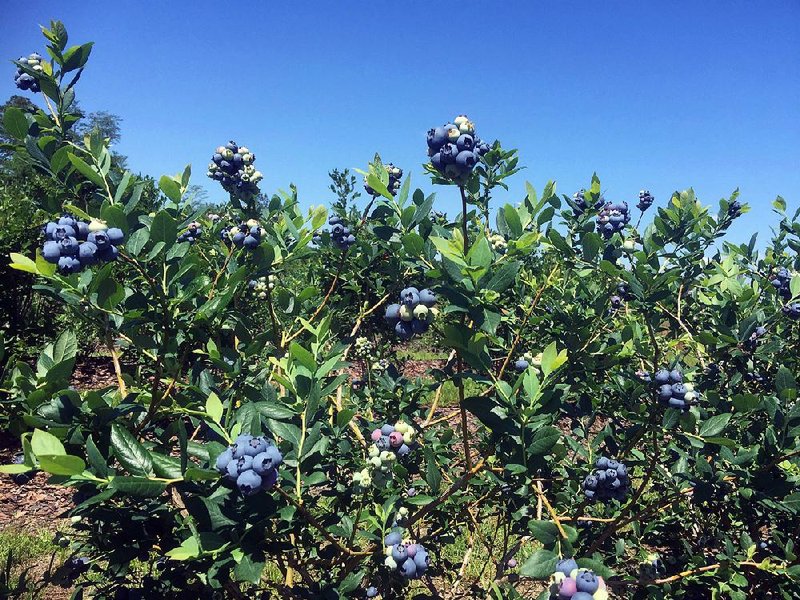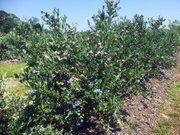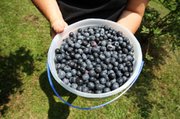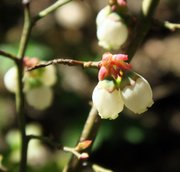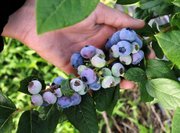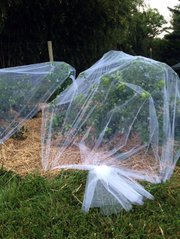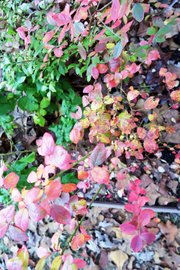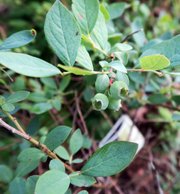Loaded with vitamins, antioxidants and other good things, blueberries are the trendy health fruit of summer. This isn't hype: Have you ever seen a sick catbird?
If you don't net your blueberry bushes, the catbird will clean you out, taking fruit once the berries start turning from pink to blue, a good two weeks before they're fully ripened. Other creatures may join the free-for-all, including robins, doves, squirrels and chipmunks. It's usually the catbirds, in my experience.
In a reasonable world, you might arrange for the catbird to take 10 percent of the berries, a tithe for its role as garden jester, and leave the rest for the gardener. But it doesn't work that way. The catbird cannot count. We are the motley fools.
Such thievery is one of the marks against blueberries, unless your aim is to nurture wildlife. A few years ago, I thought the blueberry was the perfect shrub to take out of the orchard and place in the ornamental garden, much as you might plant a viburnum or fothergilla. It had a lot going for it. It was a native plant that wasn't sickly, would work in full sun or partial shade, and provide year-round interest with its spring blooms, the fruit of summer, the scarlet leaves of the fall, and the striking orange and red twigs in winter.
But there is a price for all this value: Blueberry bushes are particular about growing conditions. They want acidic, organically rich soil that stays moist but not wet. The more organic matter you incorporate, the easier it is to meet those needs, but if you stick a blueberry bush in common clay soil and walk away, it will start to decline -- and rapidly if the soil dries out.
The blueberry is also inherently twiggy and needs proficient pruning annually to keep it looking good and fruitful. I grew one, but it declined and died, hastened by a location that turned out to be too wet. If I had been smarter, I would have noticed the problem earlier, and also planted other blueberry bushes to improve pollination and fruit set.
I don't see many blueberry bushes in gardens I visit; I suspect their fussiness has worked against them.
But while the home gardener may have cooled to this plant, farmers, breeders
and growers have gone to town with the blueberry. In the United States, per-capita consumption grew by 50 percent between 2010 and 2015 as the blueberry became popular as a health food. Growers have responded by increasing the size and geographic range of blueberry plantations.
Much of this is down to breeding efforts that have brought far more varieties into play in places with mild winters. The traditional highbush blueberry, the sort you might find in the blueberry fields of New Jersey or Michigan, doesn't fly in states like Florida because it needs long, cold winters to set fruiting buds.
Southern growers have a species called rabbiteye blueberry, which is generally a larger shrub than the highbush with smaller and sweeter berries. Hybridizers in southern agricultural schools, particularly the University of Georgia and the University of Florida, have been able to cross the highbush blueberry with rabbiteye (Zones 7-9) and other species to create a type known as southern highbush (USDA Planting Zones 5-10, which includes all of Arkansas). Many of them fruit in the spring, allowing growers in the Southeast to get premium prices for the first blueberries of the season. (These varieties have also helped fuel blueberry farms in Mexico and California.)
The raft of new varieties offers a potential boon to gardeners as well. In northern Arkansas the blueberry fancier has a choice of some classic varieties of northern highbush (Bluecrop being the standard-bearer), along with new, high-performing southern highbush types, which are hardy down to about 5 degrees. The southern highbush varieties should be grown in the southern two thirds of the state.
The rabbiteyes are on the tender side, but in favorable locations they are generally less fussy about soil and moisture. Be sure to check the planting zone before buying. Newer rabbiteye varieties offer some tangible advances. The following varieties all are rated for Zones 6b through 9, which makes them OK for gardeners across the state, except the most northwestern corner, which is in Zone 6A. From hybridizer Scott NeSmith's breeding program at the University of Georgia come two large-fruited rabbiteyes -- Titan and Krewer. In Maryland extension service trials in Upper Marlboro, an older rabbiteye named Brightwell proved exceptionally vigorous and fruitful (and hardy). Of southern highbush types, Legacy and Ozarkblue performed the best.
Michael McConkey, owner of Edible Landscaping in Afton, Va., also commends two other of NeSmith's rabbiteye introductions, Ochlockonee and Alapaha.
Jon Traunfeld, extension specialist with the Maryland Home and Garden Information Center, has been growing southern highbush blueberries in his own garden in Ellicott City, Md., for five years with no hardiness problems. He grows Ozarkblue, Reveille and O'Neal.
McConkey likes Legacy for its site adaptability, generous fruiting and sweet flavor.
NeSmith has introduced specifically for the home gardener Blue Suede, a southern highbush, and Summer Sunset, a smaller rabbiteye with multicolored berries. Others are in the works, he said.
Some nurseries sell blueberries for containers, dwarf or small varieties bred from northern species. I don't see these as low-maintenance plants as they require watering on a near-daily basis in high summer.
Don't count on much of a harvest if you don't somehow protect the bushes during berry season. Some people build large cages with doors, but that works against integrating the blueberry into the landscape.
Frank Gouin, a fruit grower and retired horticultural professor in Deale, Md., uses standard half-inch bird netting over a frame of wooden posts. One year, he substituted the netting with balloons with big eyes. They worked for a couple of weeks, but then the birds associated the balloons with a party and helped themselves even before the fruit had turned blue.
Traunfeld and McConkey have found another tactic: tulle. Cheap by the yard, it can be used to cover each bush. "I just stake it at the corners with landscape staples," Traunfeld said. "I used to spend a lot of time with bird netting, but this is really nice."
Gouin also recommends a wire guard around the base of the shrub to keep rabbits and voles from chewing the bark.
Fruiting for highbush blueberries is much improved by planting at least two different varieties that bloom concurrently, and is essential with rabbiteyes. The catbirds will thank you.
HomeStyle on 08/26/2017
